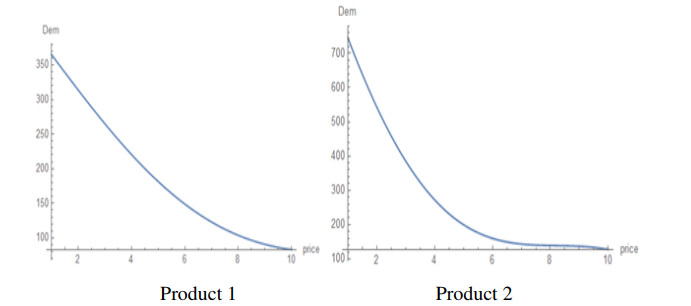1.
Introduction
The Forchheimer model equation describes the flow in a polar medium, which is widely used in fluid mechanics (see [1,2]). Increasing scholars have studied the spatial properties of the solution to the fluid equation defined on a semi-infinite cylinder, and a large number of results have emerged (see [3,4,5,6,7,8,9]).
In 2002, Payne and Song [3] have studied the following Forchheimer model
where i=1,2,3. ui,p,T represent the velocity, pressure, and temperature of the flow, respectively. gi is a known function. Δ is the Laplace operator, γ>0 is a constant, and b is the Forchheimer coefficient. For simplicity, we assume that
In (1.1)–(1.3), Ω is defined as
where D is a bounded simply-connected region on (x1,x2)-plane.
In this paper, the comma is used to indicate partial differentiation and the usual summation convection is employed, with repeated Latin subscripts summed from 1 to 3, e.g., ui,jui,j=∑3i,j=1(∂ui∂xj)2. We also use the summation convention summed from 1 to 2, e.g., uα,βuα,β=∑2α,β=1(∂uα∂xβ)2.
The Eqs (1.1)–(1.3) also satisfy the following initial-boundary conditions
where fi and H are differentiable functions.
In this paper, we will study the structural stability of Eqs (1.1)–(1.8) on Ω by using the spatial decay results obtained in [3]. Since the concept of structural stability was proposed by Hirsch and Smale [10], the structural stability of various types of partial differential equations defined in a bounded domain has received sufficient attention(see [11,12,13,14,15,16,17,18,19]). Some perturbations are inevitable in the process of model establishment and simplification, so it is necessary to study that whether such small perturbations of the equations themselves will cause great changes in the solutions. This gives rise to the phenomenon of structural stability.
If the bounded domain is replaced by a semi-infinite pipe, the structural stability of the partial differential equations is very interesting and has begun to attract attention. Li and Lin [20] considered the continuous dependence on the Forchheimer coefficient of Forchheimer equations in a semi-infinite pipe. Different from the studies of[11,12,13,14,15,16,17,18,19], we should consider not only the time variable but also the space variable. Therefore, the methods in the literature cannot be directly applied to the semi-infinite region. Compared with [3], we not only reconfirmed the spatial decay result of [3], but also proved the structural stability of the solution to b and γ.
We also introduce the notations:
where z is a running variable along the x3 axis.
2.
A prior bounds
First, to obtain the main result, we shall make frequent use of the following three inequalities.
Lemma 2.1.(see[21]) If ϕ is a Dirichlet integrable function on Ω and ∫Ωϕdx=0, then there exists a Dirichlet integrable function w=(w1,w2,w3) such that
and a positive constant k1 depends only on the geometry of Ω such that
Lemma 2.2.(see [3,4]) If ϕ|∂D=0, then
where λ is the smallest positive eigenvalue of
Here Δ2 is a two-dimensional Laplace operator.
Now, we give a lemma which has been proved by Horgan and Wheeler [4] and has been used by Payne and Song [6].
Lemma 2.3.(see [3,4]) If ϕ is a Dirichlet integrable function and ϕ|∂D=0,ϕ→∞ (as x3→∞),
where k2>0.
Lemma 2.4. If ϕ∈C10(Ω), then
where [22,23] have proved that the optimal value of Λ is determined to be Λ=127(34)4.
Using the maximum principle for the temperature T, we can have the following lemma which has been used in Song [5].
Lemma 2.5. Assume that H∈L∞(Ω), then
where TM=supΩ×{t>0}H.
Second, we list some useful results which have been derived by Payne and Song [3].
Payne and Song have established a function
where a1 and a2 are positive constants. From Eqs (3.27) and (3.36) of [3], we know that
where k3 is a positive constant and k4(t) is a function related to the boundary values.
Combining Eqs (2.1) and (2.2), we have the following lemma.
Lemma 2.6. Assume that H∈L∞(Ω) and ∫DfdA=0, then
In order to derive the main result, we need bounds for ||u||2L2(Ω) and ||u||3L2(Ω).
Lemma 2.7. Assume that fi∈H1(Ω),H,˜H∈L∞(Ω), ∫Df3dA=0 and fα,α−γf3=0 then
where k6(t) is a positive function.
Proof. To deal with boundary terms, we set S=(S1,S2,S3), where
Using Eq (1.1), we have
Using the divergence theorem, we have
Using the Hölder inequality and Young's inequality, we have
Inserting Eqs (2.5)–(2.8) into Eq (2.4) and choosing that ε1=34, we obtain
After choosing
we can complete the proof of Lemma 2.7.
3.
Important lemma
In this section, we derive an important lemma which leads to our main result.
Assume that (u∗i,T∗,p∗) is a solution of Eqs (1.1)–(1.8) when b=b∗. If we let
then (Di,Σ,π) satisfies
We can have the following lemma.
Lemma 3.1. Assume that (Di,Σ,π) is a solution to Eqs (3.1)–(3.6) with ∫Df3dA=0,H∈L∞(Ω) and the boundary data (e.g., H) satisfies Eq (3.21), then
where n∗6 is the maximum of n6(t) and n6(t),n7(t) will be defined in Eq (3.39).
Proof. We define an auxiliary function
where ω>0.
Using the divergence theorem and Eq (3.1), we have
Since
from Eq (3.9) we have
Using the Hölder inequality, Young's inequality and Lemma 2.6, we obtain
Using the Hölder inequality, Young's inequality and Lemmas 2.3 and 2.7, we obtain
Calculating the differential of Eq (3.10) and then inserting Eqs (3.11)–(3.13) into Eq (3.10), we have
where we have dropped the fourth term of Eq (3.10).
Similarly, we have
Using the divergence theorem and Eq (3.2), we have
Using the Hölder inequality and Lemma 2.5, we have
Calculating the differential of Eq (3.16) and then inserting Eq (3.17) into Eq (3.16), we have
Now, we define
Combining Eqs (3.14) and (3.18), we have
Choosing ω>4γ2T2M and the boundary data (e.g., H) satisfies
from Eq (3.20) we obtain
Integrating Eq (3.22) from z to ∞, we obtain
We note that
According to Lemma 2.1, there exists a vector function w=(w1,w2,w3) such that
Therefore, using Eq (3.1) we obtain
Since
we have
Using the Hölder inequality, Lemmas 2.2, 2.3, 2.1, 2.7 and 2.6, and Young's inequality, we obtain
Using the Hölder inequality, Lemmas 2.3, 2.1 and 2.7, and Young's inequality, we obtain
Using the Hölder inequality, Lemmas 2.4, 2.1 and 2.7, and Young's inequality, we obtain
Inserting Eqs (3.26)–(3.28) into Eq (3.25), we have
Using the Hölder inequality, Young's inequality and Lemmas 2.5, 2.2, 2.1, 2.7 and 2.3, we have
Inserting Eqs (3.29)–(3.32) into Eq (3.24), we obtain
where
Now, we begin to derive a bound of \Phi_2(z, t) which has been defined in Eq (3.15). Using the Hölder inequality, Young's inequality, Lemmas 2.7 and 2.3, we have
Inserting Eqs (3.34)–(3.36) into Eq (3.15), we obtain
Combining Eqs (3.19), (3.22), (3.33) and (3.37), we obtain
where
4.
Continuous dependence on the coefficient b
In this section, we will analysis Lemma 3.1 to derive the following theorem.
Theorem 4.1. Let (u_i, T, p) and (u_i^*, T^*, p^*) be solutions of the Eqs (1.1)–(1.8) in \Omega , corresponding to b_1 and b_2 , respectively. If \int_Df_3dA = 0 , Equation (3.21) holds and f_{\alpha, \alpha}-\gamma_1f_3 = 0, H\in L^\infty(\Omega\times\{t > 0\}) , then
Specifically, either the inequality
holds, or the inequality
holds.
Proof. Using Lemma 3.1, we have
Now, we consider (4.1) for two cases.
Ⅰ. If n_6^* = k_3 , we integrate Eq (4.1) from 0 to z to obtain
Ⅱ. If n_6^*\neq k_3 , we integrate Eq (4.1) from 0 to z to obtain
From Eqs (4.2) and (4.3), to obtain the main result, we can conclude that we have to derive a bound for \Phi(0, t) . We choose z = 0 in Lemma 3.1 to obtain
Clearly, if we want to derive a bound for \Phi(0, t) , we only need derive a bound for -\frac{\partial \Phi}{\partial z}(0, t) . To do this, choosing z = 0 in Eq (3.19) and combining Eqs (3.8) and (3.15), we have
In light of the boundary conditions (3.4)–(3.6), from Eq (4.5) we can know that
Inserting Eq (4.6) into Eq (4.4), we obtain
Therefore, from Eqs (4.2), (4.3) and (4.7) we have
Combining Eqs (3.24), (4.8) and (4.9) we can complete the proof of Theorem 4.1.
Remark 4.1 Theorem 1 shows that the small perturbation of Forchheimer coefficient will not cause great changes to the solution of Eqs (1.1)–(1.8). Meanwhile, Theorem 1 also shows that the solutions of Eqs (2.12)–(2.21) decay exponentially as the space variable z\rightarrow \infty .
5.
Continuous dependence on the coefficient \gamma
This section shows how to use the prior estimates in Section 2 and the method in Section 3 to derive the continuous dependence of the solution on \gamma . Assume that (u_i^*, T^*, p^*) is a solution of Eqs (1.1)–(1.8) with \gamma = \gamma^* .
If we also let
then (\mathcal{D}_i, \Sigma, \pi) satisfies
We also define \Phi_1(z, t) as that in Eq (3.8). Similar to Eq (3.10), we have
Using the Hölder inequality, Young's inequality and Lemmas 2.5 and 2.6, we obtain
Combining Eqs (3.12), (3.13), (5.8) and (5.9), we obtain
Inserting Eqs (3.18) and (5.10) into Eq (3.19), choosing \omega > \frac{4T_M^2}{\gamma^2} and the boundary data satisfies
we have
Integrating Eq (5.12) from z to \infty , we obtain
Similar to the calculation in Eqs (3.33) and (3.37), we can get
for n_6'(t), n_7'(t) > 0 .
After similar analysis as in the previous section, we can get the following theorem from Eq (5.14).
Theorem 5.1. Let (u_i, T, p) and (u_i^*, T^*, p^*) be solutions of the Eqs (1.1)–(1.8) in \Omega , corresponding to b_1 and b_2 , respectively. If \int_Df_3dA = 0 , Equation (5.11) holds and f_{\alpha, \alpha}-\gamma_1f_3 = 0, H\in L^\infty(\Omega\times\{t > 0\}) , then
Specifically, either the inequality
holds, or the inequality
holds.
6.
Conclusions
In this paper, using a priori estimates of the solutions, we show how to control the nonlinear term, and obtain the structural stability of the solution of the Forchheimer equation in a semi-infinite cylinder. Meanwhile, the spatial decay results of the solution are also obtained. The methods in this paper can bring some inspiration for the structural stability of other nonlinear partial differential equations.
Acknowledgments
The authors express their heartfelt thanks to the editors and referees who have provided some important suggestions. This work is supported by the Tutor System Rroject of Guangzhou Huashang College (2021HSDS13) and the Key projects of universities in Guangdong Province (NATURAL SCIENCE) (2019KZDXM042).
Conflict of interest
The authors declare there is no conflict of interest. Conceptualization, and validation, Z. Li.; formal analysis, Z W. Zhang; investigation, Y. Li. All authors have read and agreed to the published version of the manuscript.




















 DownLoad:
DownLoad: